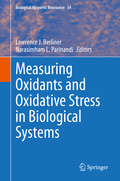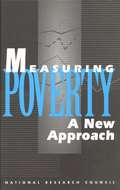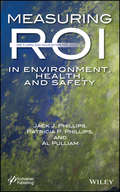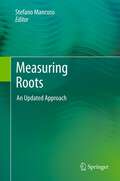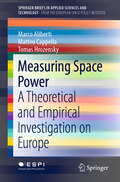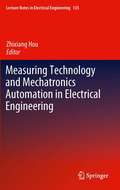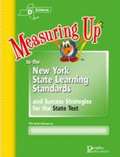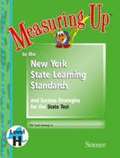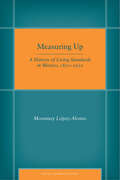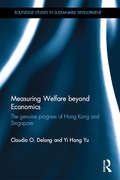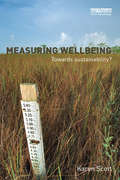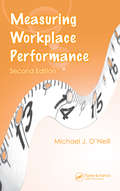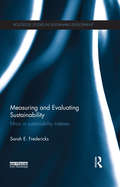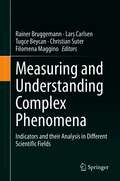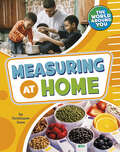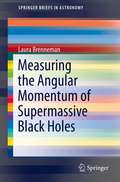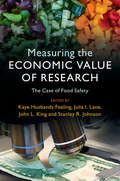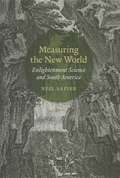- Table View
- List View
Measuring Oxidants and Oxidative Stress in Biological Systems (Biological Magnetic Resonance #34)
by Narasimham L. Parinandi Lawrence J. BerlinerThis book describes the methods of analysis and determination of oxidants and oxidative stress in biological systems. Reviews and protocols on select methods of analysis of ROS, RNS, oxygen, redox status, and oxidative stress in biological systems are described in detail. It is an essential resource for both novices and experts in the field of oxidant and oxidative stress biology.
Measuring Penny
by Loreen LeedyLisa learns about the mathematics of measuring by measuring her dog Penny with all sorts of units, including pounds, inches, dog biscuits, and cotton swabs.
Measuring Poverty: A New Approach
by Constance F. Citro Robert T. MichaelEach year's poverty figures are anxiously awaited by policymakers, analysts, and the media. Yet questions are increasing about the 30-year-old measure as social and economic conditions change. In Measuring Poverty a distinguished panel provides policymakers with an up-to-date evaluation of Concepts and procedures for deriving the poverty threshold, including adjustments for different family circumstances. Definitions of family resources. Procedures for annual updates of poverty measures. The volume explores specific issues underlying the poverty measure, analyzes the likely effects of any changes on poverty rates, and discusses the impact on eligibility for public benefits. In supporting its recommendations the panel provides insightful recognition of the political and social dimensions of this key economic indicator. Measuring Poverty will be important to government officials, policy analysts, statisticians, economists, researchers, and others involved in virtually all poverty and social welfare issues.
Measuring ROI in Environment, Health, and Safety
by Jack J. Phillips Patricia Pulliam Phillips Al PulliamWithin an organization, the responsibilities for environment, health, and safety are often under the direction of the same executive team in an organization. This new book shows how to measure the success of all types of programs and projects involving environment initiatives, health related programs for employees and citizens, and various safety programs in all types of settings. It also explains how to report results by using a step-by-step approach.
Measuring Roots
by Stefano MancusoRoots represent half of the plant body - and arguably the more interesting half. Despite its obvious importance for the whole plant, until recently our knowledge of the root apparatus was very limited, mostly due to the inadequacy of the techniques available. Recent advances in the visualization and measurement of roots have resulted in significant progress in our understanding of root architecture, growth and behaviour. In this book international experts highlight the most advanced techniques, both lab and field methods, and discuss them in detail. Measuring Roots combines academic and practical aspects of this topic, making it a universal handbook for all researchers and others interested in root-measuring methods.
Measuring Shadows: Kepler’s Optics of Invisibility
by Raz Chen-MorrisIn Measuring Shadows, Raz Chen-Morris demonstrates that a close study of Kepler’s Optics is essential to understanding his astronomical work and his scientific epistemology. He explores Kepler’s radical break from scientific and epistemological traditions and shows how the seventeenth-century astronomer posited new ways to view scientific truth and knowledge. Chen-Morris reveals how Kepler’s ideas about the formation of images on the retina and the geometrics of the camera obscura, as well as his astronomical observations, advanced the argument that physical reality could only be described through artificially produced shadows, reflections, and refractions. Breaking from medieval and Renaissance traditions that insisted upon direct sensory perception, Kepler advocated for instruments as mediators between the eye and physical reality, and for mathematical language to describe motion. It was only through this kind of knowledge, he argued, that observation could produce certainty about the heavens. Not only was this conception of visibility crucial to advancing the early modern understanding of vision and the retina, but it affected how people during that period approached and understood the world around them.
Measuring Shadows: Kepler’s Optics of Invisibility
by Raz Chen-MorrisIn Measuring Shadows, Raz Chen-Morris demonstrates that a close study of Kepler’s Optics is essential to understanding his astronomical work and his scientific epistemology. He explores Kepler’s radical break from scientific and epistemological traditions and shows how the seventeenth-century astronomer posited new ways to view scientific truth and knowledge. Chen-Morris reveals how Kepler’s ideas about the formation of images on the retina and the geometrics of the camera obscura, as well as his astronomical observations, advanced the argument that physical reality could only be described through artificially produced shadows, reflections, and refractions.Breaking from medieval and Renaissance traditions that insisted upon direct sensory perception, Kepler advocated for instruments as mediators between the eye and physical reality, and for mathematical language to describe motion. It was only through this kind of knowledge, he argued, that observation could produce certainty about the heavens. Not only was this conception of visibility crucial to advancing the early modern understanding of vision and the retina, but it affected how people during that period approached and understood the world around them.
Measuring Space Power: A Theoretical and Empirical Investigation on Europe (SpringerBriefs in Applied Sciences and Technology)
by Marco Aliberti Matteo Cappella Tomas HrozenskyThis book provides an in-depth investigation of the concept of space power and devises a novel conceptual framework for empirically measuring and comparing different typologies of space actors on the basis of clearly defined criteria. In turn, the book identifies a comprehensive set of conditions required to achieve and maintain the status of space power and explores the main political, security, and socio-economic stakes involved. Building on this basis, the book conducts a comparative assessment of the major space actors, the underlying aim of which is to examine Europe’s relative position in the space arena and put into perspective its proclaimed goal to assert itself as a space power, with all of the means and resources this would entail. Given its scope, the book represents a valuable and versatile tool to support European decision-making and offers key insights for executives, space professionals and scholars alike.
Measuring Technology and Mechatronics Automation in Electrical Engineering
by Zhixiang HouMeasuring Technology and Mechatronics Automation in Electrical Engineering includes select presentations on measuring technology and mechatronics automation related to electrical engineering, originally presented during the International Conference on Measuring Technology and Mechanatronics Automation (ICMTMA2012). This Fourth ICMTMA, held at Sanya, China, offered a prestigious, international forum for scientists, engineers, and educators to present the state of the art of measuring technology and mechatronics automation research.
Measuring Up to the New York State Learning Standards and Success Strategies for the State Test (Science Level D)
by Peoples Publishing GroupMeasuring Up worktexts maximize instruction time with 100 percent customization to the NYS Learning Standards. Lessons contain guided instruction and many application activities.
Measuring Up to the New York State Learning Standards and Success Strategies for the State Test: Science, Level H, Grade 8 (Measuring Up)
by Peoples Education Staff<p>Measuring Up to the New York State Learning Standards and Success Strategies for the State Test (Level H-Science). <p>This book is customized for New York and the lessons match the New York State Learning Standards. The Measuring Up program includes comprehensive worktexts and New York Diagnostic Practice Tests, which are available separately. <p>This worktext is customized to the New York Intermediate Science Core Curriculum and will help you prepare for the New York State Evaluation Test in Science for Grade 8.</p>
Measuring Up to the Texas Essential Knowledge and Skills (Level D Science)
by Editors at the Peoples EducationTexas 4th Grade Science Test Prep
Measuring Up: A History of Living Standards in Mexico, 1850-1950
by Moramay Lopez-AlonsoMeasuring Uptraces the high levels of poverty and inequality that Mexico faced in the mid-twentieth century. Using newly developed multidisciplinary techniques, the book provides a perspective on living standards in Mexico prior to the first measurement of income distribution in 1957. By offering an account of material living conditions and their repercussions on biological standards of living between 1850 and 1950, it sheds new light on the life of the marginalized during this period. Measuring Upshows that new methodologies allow us to examine the history of individuals who were not integrated into the formal economy. Using anthropometric history techniques, the book assesses how a large portion of the population was affected by piecemeal policies and flaws in the process of economic modernization and growth. It contributes to our understanding of the origins of poverty and inequality, and conveys a much-needed, long-term perspective on the living conditions of the Mexican working classes.
Measuring Welfare beyond Economics: The genuine progress of Hong Kong and Singapore (Routledge Studies in Sustainable Development)
by Claudio O. Delang Yi Hang YuDissatisfaction with the Gross Domestic Product (GDP) as an indicator of a country’s development or a population’s wellbeing led to the development of the Genuine Progress Indicator (GPI). The GPI is an aggregate index of over 20 economic, social and environmental indicators, and accounts for both the welfare benefits of economic growth, and the social and environmental costs which accompany that economic growth. The result is better information about the level of welfare or well-being of a country’s population. This book measures the GPI of Hong Kong and Singapore from 1968 to 2010. It finds that for both countries, economic output (as measured by the GDP) has grown more than welfare (as measured by the GPI), but important differences are also found. In Hong Kong, the GPI has grown for the whole period under consideration, while in Singapore the GPI has stalled from 1993. This is in line with most countries and is explained by the "threshold hypothesis" which states that beyond a certain level of economic development the benefits of further economic growth are outweighed by even higher environmental and social costs. The book argues that the growth of Hong Kong’s GPI is due to its favourable relationship with China and in particular its ability to export low-wage jobs and polluting industries, rather than successful domestic policies. A stalling or shrinking GPI calls for alternative policies than the growth economy promoted by neoclassical economists, and the book explores an alternative model, that of the Steady State Economy (SSE).
Measuring Wellbeing: Towards Sustainability?
by Karen ScottImproving wellbeing and sustainability are central goals of government, but are they in conflict? This engaging new book reviews that question and its implications for public policy through a focus on indicators. It highlights tensions on the one hand between various constructs of wellbeing and sustainable development, and on the other between current individual and societal notions of wellbeing. It recommends a clearer conceptual framework for policy makers regarding different wellbeing constructs which would facilitate more transparent discussions. Arguing against a win-win scenario of wellbeing and sustainability, it advocates an approach based on recognising and valuing conflicting views where notions of participation and power are central to discussions. Measuring Wellbeing is divided into two parts. The first part provides a critical review of the field, drawing widely on international research but contextualised within recent UK wellbeing policy discourses. The second part embeds the theory in a case study based on the author’s own experience of trying to develop quality of life indicators within a local authority, against the backdrop of increasing national policy interest in measuring ‘happiness’. This accessible and informative book, covering uniquely both practice and theory, will be of great appeal to students, academics and policy makers interested in wellbeing, sustainable development, indicators, public policy, community participation, power and discourse.
Measuring Workplace Performance
by Michael J. O'NeillMost Fortune 1000 companies still struggle with workspace planning and design issues. They invest millions of dollars each year with the expectation that new buildings and major renovations will help transform their culture, support innovation, strengthen desired behaviors and increase organizational effectiveness. Providing a biological framework, this book explores how the design of the work environment can be used as a tool to further business goals as well as improve individual and group performance. The second edition of a bestseller, the book includes many new case studies with Fortune 1000 companies. It features a new section on Six Sigma measurement methods for assessing office workspace effectiveness. The Case Studies demonstrate how office workspace design affects employee performance, and how to use this information to optimize workplace design for individuals and groups. It focuses on the emergence and application of Six-Sigma quality principles and methods in the evaluation and improvement of workspaces.
Measuring and Evaluating Sustainability: Ethics in Sustainability Indexes (Routledge Studies in Sustainable Development)
by Sarah E. FredericksThe indexes used by local, national, and international governments to monitor progress toward sustainability do not adequately align with their ethical priorities and have a limited ability to monitor and promote sustainability. This book gives a theoretical and practical demonstration of how ethics and technical considerations can aid the development of sustainability indexes to overcome this division in the literature and aid sustainability initiatives. Measuring and Evaluating Sustainability develops and illustrates methods of linking technical and normative concerns during the development of sustainability indexes. Specifically, guidelines for index development are combined with a pragmatic theory of ethics that enables ethical collaboration among people of diverse ethical systems. Using the resulting method of index development, the book takes a unique applied turn as it ethically evaluates multiple sustainability indexes developed and used by the European Commission, researchers, and local communities and suggests ways to improve the indexes. The book emphasizes justice as it is the most prevalent ethical principle in the sustainability literature and most neglected in index development. In addition to the ethical principles common to international sustainability initiatives, the book also employs a variety of religious and philosophical traditions to ensure that the ethical evaluations performed in the text align with the ideals of the communities using the indexes and foster cross-cultural ethical dialogue. This volume is an invaluable resource for students, researchers and professionals working on sustainability indicators and sustainability policy-making as well as interdisciplinary areas including environmental ethics; environmental philosophy; environmental or social justice; ecological economics; businesses sustainability programs; international development and environmental policy-making.
Measuring and Understanding Complex Phenomena: Indicators and their Analysis in Different Scientific Fields
by Christian Suter Filomena Maggino Lars Carlsen Rainer Bruggemann Tugce BeycanIndicators are more and more applied to describe and analyze complex systems. Typical examples: Innovation potential of nations, child-well being, Environmental health, poverty, chemical pollution, corruption of nations. The task is: How can a system of indicators be defined in order to fulfill the above expectations. One possibility is the application of the mathematical theory of partial order, especially when the indicator system shall be used for ranking purposes.
Measuring at Home (The World Around You)
by Christianne JonesYour house is packed with big things and small things and everything in-between. How tall is your refrigerator? How long is your bed? How wide is your door? Colorful photographs and interactive, rhyming text will have early learners ready to measure after reading this picture book.
Measuring the Angular Momentum of Supermassive Black Holes
by Laura BrennemanMeasuring the spin distribution of supermassive black holes is of critical importance for understanding how these black holes and their host galaxies form and evolve over time, yet this type of study is only in its infancy. This brief describes how astronomers measure spin in supermassive black holes using X-ray spectroscopy. It also reviews the constraints that have been placed on the spin distribution in local, bright active galaxies over the past six years, and the cosmological implications of these constraints. Finally, it summarizes the open questions that remain in this exciting new field of research and points toward future discoveries soon to be made by the next generation of space-based observatories.
Measuring the Economic Value of Research: The Case Of Food Safety
by Kaye Husbands Fealing Julia I. Lane John L. King Stanley R. JohnsonThe scientific advances that underpin economic growth and human health would not be possible without research investments. Yet demonstrating the impact of research programs is a challenge, especially in areas that span disciplines, industrial sectors, and encompass both public and private sector activity. All areas of research are under pressure to demonstrate benefits from federal funding of research. This exciting and innovative study demonstrates new methods and tools to trace the impact of federal research funding on the structure of research, and the subsequent economic activities of funded researchers. The case study is food safety research, which is critical to avoiding outbreaks of disease. The authors make use of an extraordinary new data infrastructure and apply new techniques in text analysis. Focusing on the impact of US federal food safety research, this book develops vital data-intensive methodologies that have a real world application to many other scientific fields.
Measuring the Impacts of Federal Investments in Research: A Workshop Summary
by The National Academy of SciencesThe enactment of the America COMPETES Act in 2006 (and its reauthorization in 2010), the increase in research expenditures under the 2009 American Recovery and Reinvestment Act (ARRA), and President Obama's general emphasis on the contribution of science and technology to economic growth have all heightened interest in the role of scientific and engineering research in creating jobs, generating innovative technologies, spawning new industries, improving health, and producing other economic and societal benefits. Along with this interest has come a renewed emphasis on a question that has been asked for decades: Can the impacts and practical benefits of research to society be measured either quantitatively or qualitatively? On April 18-19, 2011, the Board on Science, Technology, and Economic Policy (STEP) and the Committee on Science, Engineering and Public Policy (COSEPUP) of the National Academy of Sciences, the National Academy of Engineering, and the Institute of Medicine, held a workshop to examine this question. The workshop sought to assemble the range of work that has been done in measuring research outcomes and to provide a forum to discuss its method. The workshop was motivated by a 2009 letter from Congressman Rush Holt (D-New Jersey). He asked the National Academies to look into a variety of complex and interconnected issues, such as the short-term and long-term economic and non-economic impact of federal research funding, factors that determine whether federally funded research discoveries result in economic benefits, and quantification of the impacts of research on national security, the environment, health, education, public welfare, and decision making. Measuring the Impacts of Federal Investments in Researchprovides the key observations and suggestions made by the speakers at the workshop and during the discussions that followed the formal presentations.
Measuring the New World: Enlightenment Science and South America
by Neil SafierPrior to 1735, South America was terra incognita to many Europeans. But that year, the Paris Academy of Sciences sent a mission to the Spanish American province of Quito (in present-day Ecuador) to study the curvature of the earth at the Equator. Equipped with quadrants and telescopes, the mission's participants referred to the transfer of scientific knowledge from Europe to the Andes as a "sacred fire" passing mysteriously through European astronomical instruments to observers in South America. By taking an innovative interdisciplinary look at the traces of this expedition, Measuring the New World examines the transatlantic flow of knowledge from West to East. Through ephemeral monuments and geographical maps, this book explores how the social and cultural worlds of South America contributed to the production of European scientific knowledge during the Enlightenment. Neil Safier uses the notebooks of traveling philosophers, as well as specimens from the expedition, to place this particular scientific endeavor in the larger context of early modern print culture and the emerging intellectual category of scientist as author.
Measuring the New World: Enlightenment Science and South America
by Neil SafierPrior to 1735, South America was terra incognita to many Europeans. But that year, the Paris Academy of Sciences sent a mission to the Spanish American province of Quito (in present-day Ecuador) to study the curvature of the earth at the Equator. Equipped with quadrants and telescopes, the mission’s participants referred to the transfer of scientific knowledge from Europe to the Andes as a “sacred fire” passing mysteriously through European astronomical instruments to observers in South America.By taking an innovative interdisciplinary look at the traces of this expedition, Measuring the New World examines the transatlantic flow of knowledge from West to East. Through ephemeral monuments and geographical maps, this book explores how the social and cultural worlds of South America contributed to the production of European scientific knowledge during the Enlightenment. Neil Safier uses the notebooks of traveling philosophers, as well as specimens from the expedition, to place this particular scientific endeavor in the larger context of early modern print culture and the emerging intellectual category of scientist as author.
